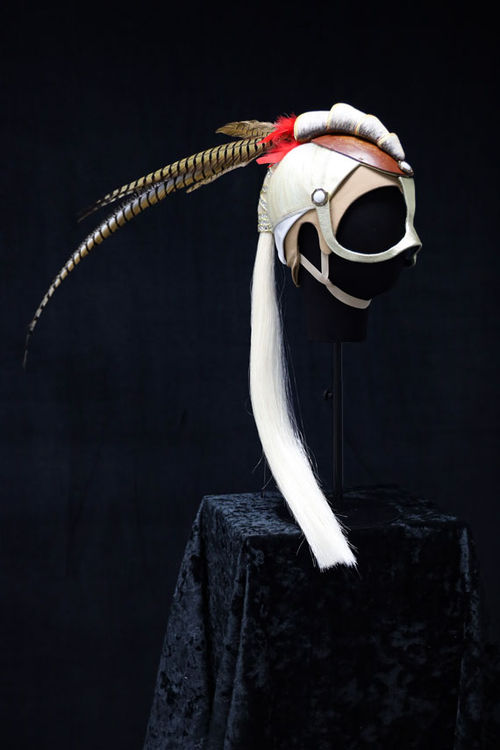Like the performers in the long-running "O," visitors to Las Vegas can do a deep dive into the behind-the scenes artistry of Cirque du Soleil's local productions in a new, free, limited-time exhibition.
The global entertainment powerhouse collaborated with the Neon Museum to create "Stories From Backstage: Cirque du Soleil in Las Vegas," which runs through May 1 in City Hall's Grand Gallery downtown.
It's the company's first museum-curated exhibition, and it features about 100 artifacts, including costumes, 3-D-printed fabrics and measurement sheets from the five Cirque du Soleil Las Vegas shows. Among the items featured: the Red Bird costume from "Mystere," the Moonhead headpiece from "O," acrobatic shoes from "Mad Apple," a HooDan warrior costume from "Ka" and makeup designs from "Michael Jackson One."
"This is a homage to the backstage. This is a side of Cirque that you never, ever get to see normally, and also up close and really personal," said Sarah Hulme, the exhibition's chief curator and deputy director of the Neon Museum.
Secrets shared
Items were selected for the exhibit after interviews were conducted with on-stage performers (often former athletes, whom Cirque calls "artists"), costume specialists and artistic directors. Elements were chosen to demonstrate "how they designed the costume to be fabulous on stage but [also] to be something that you could actually perform in, and things don't get in the way, and they don't get caught, and you can move athletically in them," Hulme said.
For example, the costume of the warrior in "Ka" is deconstructed into gloves, footwear and headpiece. How artists must complete quick changes backstage, how costumes are tagged and inventoried and even how often a costume must be replaced are explored.
In the case of the chlorine-infused water of "O," certain costumes must be retired every two months because of fading and other wear and tear. Exhibition-goers can see a new costume side by side with what Cirque calls a "dead" costume, a rare instance of an entertainment company displaying such facets.
Interactive exhibits elaborate on the steps to onboard a new performer, what body measurements are taken and even how skin tone is evaluated to match the color of the costume.
"You can discover what your Cirque du Soleil skin-tone number is should you ever become a performer and need a unitard to be made," Hulme said. Guests can feel some of the materials used to better understand how stretchy or rough they are--all in the service of the performance.
"Cirque has been with us for nearly 30 years in Las Vegas," she said. "That has evolved, and with it, so have the costume design and technologies. Some of the costumes as they were originally designed are not like that any longer. They are a different version of it, but from an audience perspective, it still has all the glitz and glamor and the sequins of before, but some of that is in digital printing and different techniques."

The HooDan warrior’s headpiece on display at "Stories From Backstage: Cirque du Soleil in Las Vegas" at City Hall through May 1. Photo Credit: Neon Museum / Cirque du Soleil
While most costumes take advantage of the technology the 21st century offers, wig-making often uses techniques that are centuries old.
In contrast to most subjects that appear in museums, Cirque du Soleil is a living entity fiercely protective of its legacy and its competitive secrets, according to Hulme. Sharing editorial control in a true collaboration for the exhibition was essential, she said.
"When you're protecting your brand, and you're giving your brand over to another organization, it's a very worrying thing to do. So as a team, we had a real appreciation for that from the beginning. What we've also done has been very respectful to always use their verbiage of things," Hulme said.
Some guests will be enamored with the costume details, others will be inspired by the artists' stories of creating and performing, but it's not essential to have seen a Cirque show to appreciate the exhibition, said Aaron Berger, executive director of the Neon Museum.
Neon Museum's role
The exhibition in the first initiative of the Neon Museum's enhanced mission statement that focuses not only on Las Vegas' past through iconic signs but also its present and future through more diverse collections and other storytelling efforts, Berger said.
"I would call us the 'Museum of Las Vegas,'" Berger said. "That's really what we are, going forward. We're able to tell so many more stories with this new vision, this new direction, and it leads into expansion efforts and our footprint and all those other fun things that are coming down the pike."
The Cirque du Soleil exhibition will also be the cornerstone of the museum's signature Duck Duck Shed, a four-day exploration into Vegas' architecture, design and culture April 24 to 27. The annual event includes other behind-the-scenes tours, programs and discussions.
The Commission for the Las Vegas Centennial, a granting arm of the city, is the primary underwriter for Duck Duck Shed. Among the reasons to stage "Stories From Backstage: Cirque du Soleil" in City Hall is to thank the city, Berger said.
Admission is free, and the exhibit is open during City Hall hours from 7 a.m. to 5:30 p.m. Mondays through Thursdays.